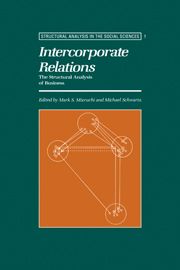Book contents
- Frontmatter
- Contents
- List of figures
- List of tables
- Introduction
- I Theoretical perspectives
- 1 A resource dependence perspective on intercorporate relations
- 2 Finance capital and the internal structure of the capitalist class in the United States
- 3 A structural approach to markets
- 4 What is money? A social structural interpretation
- 5 Corporation, class, and city system
- II National and international business structures: a comparative perspective
- Index of authors
- Subject index
2 - Finance capital and the internal structure of the capitalist class in the United States
Published online by Cambridge University Press: 04 February 2010
- Frontmatter
- Contents
- List of figures
- List of tables
- Introduction
- I Theoretical perspectives
- 1 A resource dependence perspective on intercorporate relations
- 2 Finance capital and the internal structure of the capitalist class in the United States
- 3 A structural approach to markets
- 4 What is money? A social structural interpretation
- 5 Corporation, class, and city system
- II National and international business structures: a comparative perspective
- Index of authors
- Subject index
Summary
A handful of immense banks, concentrating within their coffers the bulk of the assets and deposits of the entire banking system and providing much of the loans and credits for industry, are the decisive units in the circulation of capital in contemporary capitalist economies. With this consolidation of oligopoly in banking itself, the amount of loans and credits granted by the leading banks actually determines the amount of money deposited with them, because what they lend flows back to them as deposits. They can, within fairly wide limits, “vary at will the supply of credit or short-term capital available at any given time” and thus determine the price of (or rate of interest on) loan capital. As C. Wright Mills (1942:46) aptly remarks, “not violence, but credit may be a rather ultimate seat of control within modern societies.”
The leading banks are also structurally interconnected – through long-standing business associations, financial arrangements, interlocking directorates, and overlapping and interpenetrating ownership – with the top nonfinancial corporations. Thus, if our originating question is how this affects the dynamics of contemporary capitalism, this article focusses, in particular, on the inner structure of the capitalist class itself, and involves the following questions: Do the interconnections between the major financial institutions (banks, insurance companies, and other financial firms) and large industrial corporations constitute institutional means of intraclass power? Do the men who sit simultaneously in the managements of both of them play a distinctive role in the corporate world? Are they, in a phrase, “a special social type, in contrast to the other officers and directors of the largest corporations and banks?” (See Zeitlin, 1974: 1103, 1110; also 1976: 900–1.)
- Type
- Chapter
- Information
- Intercorporate RelationsThe Structural Analysis of Business, pp. 56 - 84Publisher: Cambridge University PressPrint publication year: 1988
- 2
- Cited by



